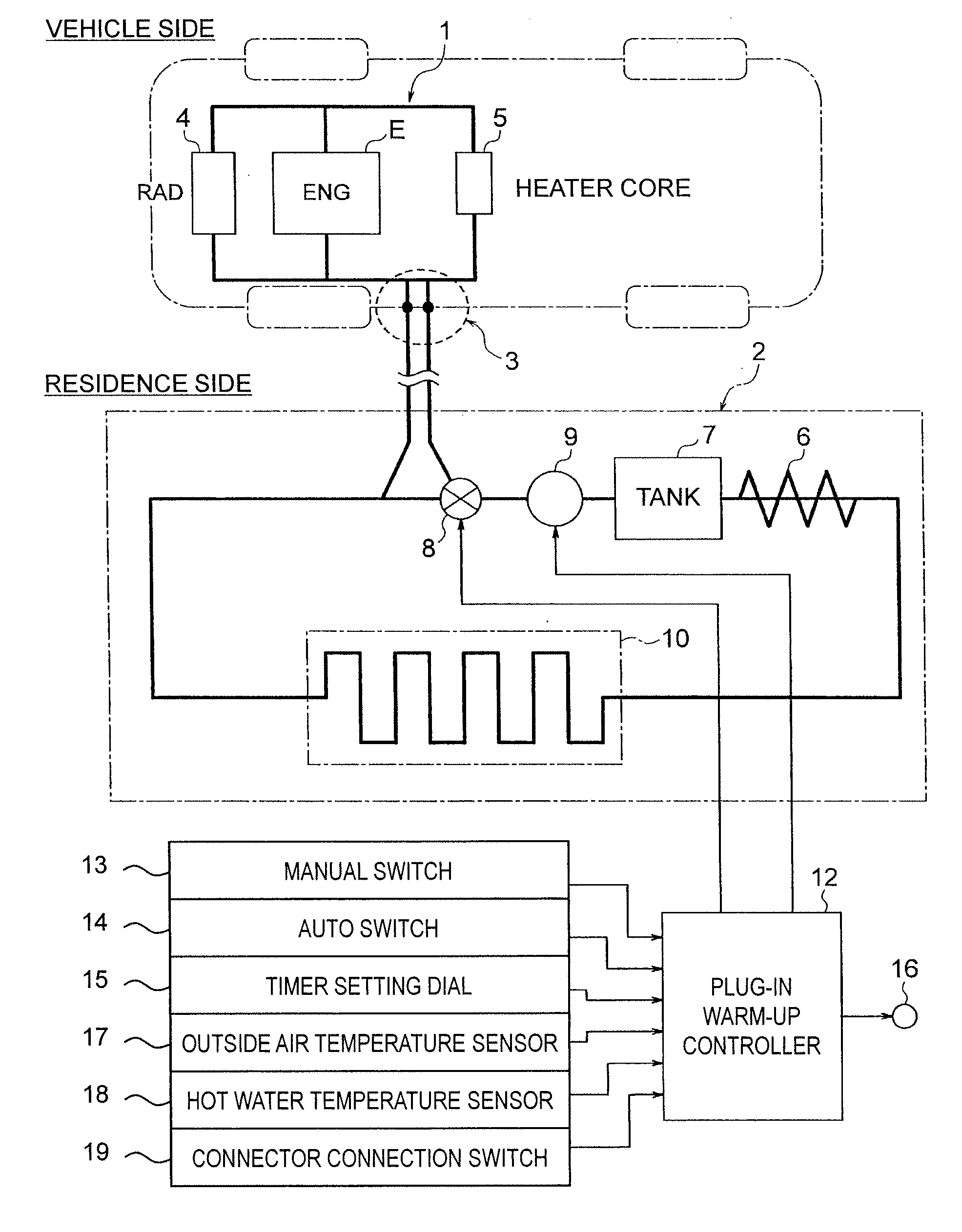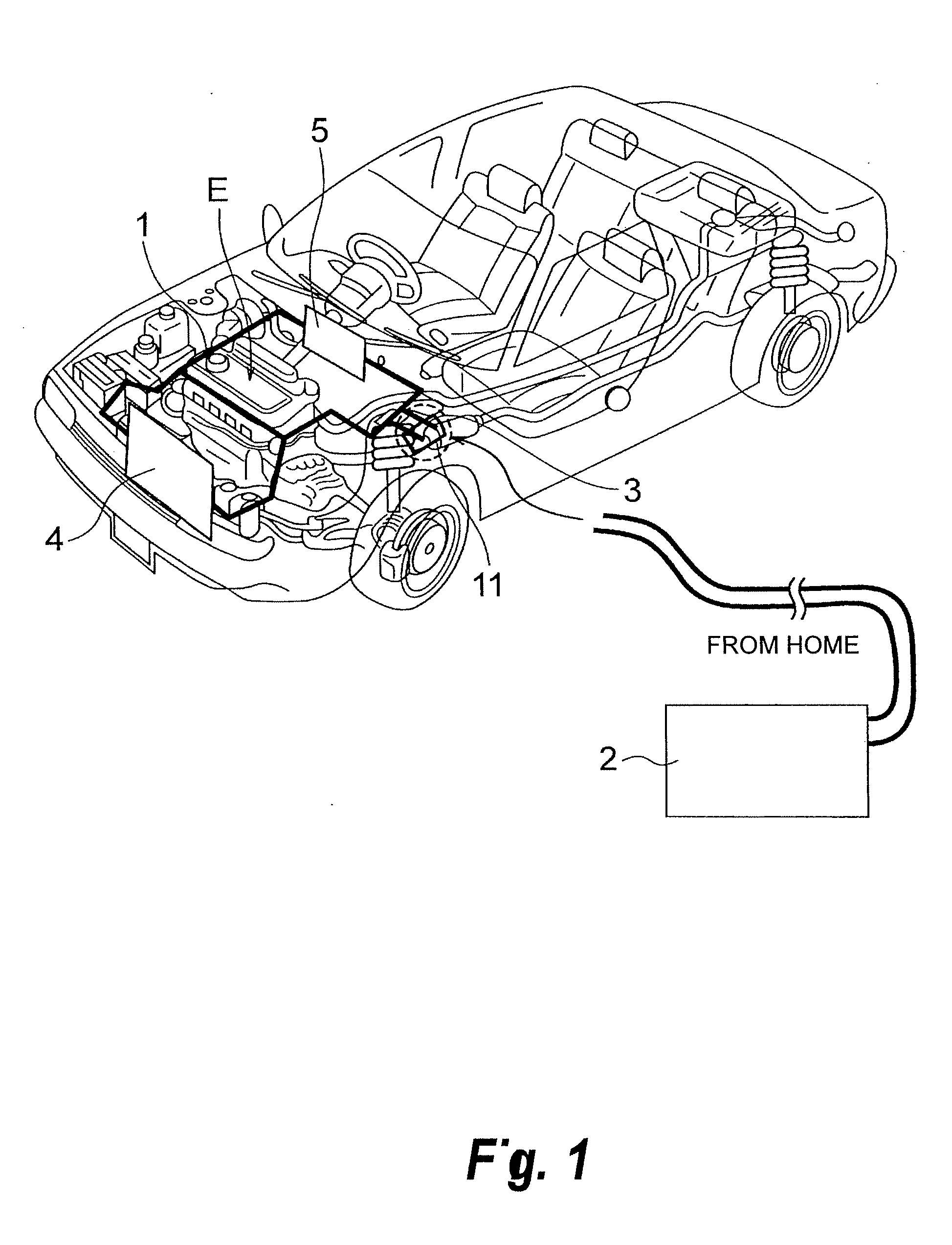Warm-up system and warm-up method for in-vehicle power train
a technology of in-vehicle power train and warm-up system, which is applied in the direction of engine starters, lighting and heating apparatus, heating types, etc., can solve the problems of increasing the number of components and a corresponding increase in weight, deteriorating fuel economy, and insufficient display of device effects, so as to reduce weight and cost, improve fuel economy, and eliminate control
- Summary
- Abstract
- Description
- Claims
- Application Information
AI Technical Summary
Benefits of technology
Problems solved by technology
Method used
Image
Examples
first embodiment
[0037]First, the constitution of this embodiment will be described. FIG. 1 is a perspective view showing an engine vehicle to which a warm-up system and a warm-up method for an engine (serving as an example of an in-vehicle power train) according to the first embodiment are applied. FIG. 2 is an illustrative view showing the engine warm-up system according to the first embodiment. FIG. 3 is a sectional view showing a state in which a connector of the engine warm-up system according to the first embodiment is disconnected immediately prior to connection. FIG. 4 is a sectional view showing a state in which the connector of the engine warm-up system according to the first embodiment is connected.
[0038]As shown in FIG. 1, the engine warm-up system according to the first embodiment pre-warms up of an engine E by transferring heat from a heat source to an engine cooling water circulation circuit 1 (vehicle side warm-up circuit) of the vehicle. A residential hot water circuit 2 (heat sourc...
second embodiment
[0096]In consideration of the use of household thermal energy to pre-warm up, the second embodiment is an example in which the temperature of the engine cooling water is raised via a heat exchanger, rather than circulating household hot water directly to the vehicle as in the first embodiment.
[0097]First, the constitution of the second embodiment will be described. FIG. 6 is an illustrative view of a warm-up system for an engine (serving as an example of an in-vehicle power train) according to the second embodiment.
[0098]As shown in FIG. 6, the engine warm-up system according to the second embodiment pre-warms up of an engine E by transferring heat from a heat source to an engine cooling water circulation circuit 1 (vehicle side warm-up circuit) of the vehicle. A residential hot water circuit 2 (heat source circuit) using a household heat source is provided as the heat source. The engine cooling water circulation circuit 1 and the residential hot water circuit 2 include a one-touch ...
third embodiment
[0107]Similarly to the second embodiment, the third embodiment is an example in which the temperature of the engine cooling water is raised via a heat exchanger, but here, the engine cooling water is warmed using household waste heat from a hot water supply, a bath, and so on instead of the floor heating heat source.
[0108]First, the constitution of this embodiment will be described. FIG. 7 is an illustrative view of a warm-up system for an engine (serving as an example of an in-vehicle power train) according to the third embodiment.
[0109]As shown in FIG. 7, the engine warm-up system according to the third embodiment pre-warms up of an engine E by transferring heat from a heat source to an engine cooling water circulation circuit 1 (vehicle side warm-up circuit) of the vehicle. A residential hot water circuit 2 (heat source circuit) using a household heat source is provided as the heat source. The engine cooling water circulation circuit 1 and the residential hot water circuit 2 incl...
PUM
 Login to View More
Login to View More Abstract
Description
Claims
Application Information
 Login to View More
Login to View More - R&D
- Intellectual Property
- Life Sciences
- Materials
- Tech Scout
- Unparalleled Data Quality
- Higher Quality Content
- 60% Fewer Hallucinations
Browse by: Latest US Patents, China's latest patents, Technical Efficacy Thesaurus, Application Domain, Technology Topic, Popular Technical Reports.
© 2025 PatSnap. All rights reserved.Legal|Privacy policy|Modern Slavery Act Transparency Statement|Sitemap|About US| Contact US: help@patsnap.com



